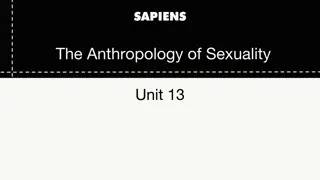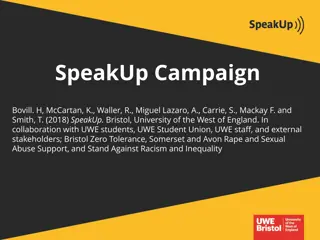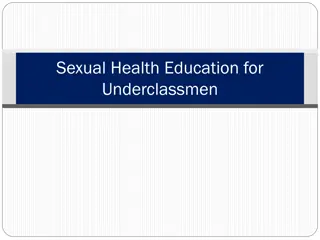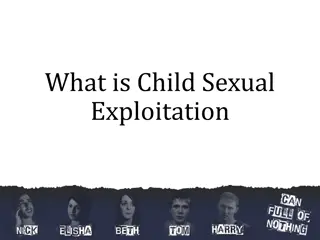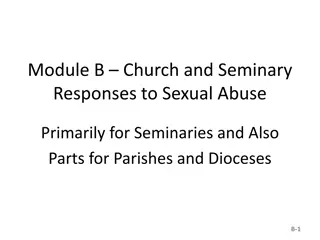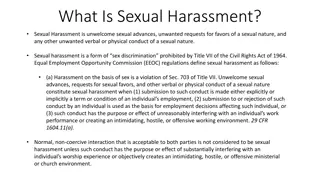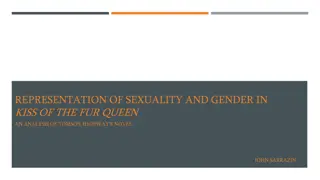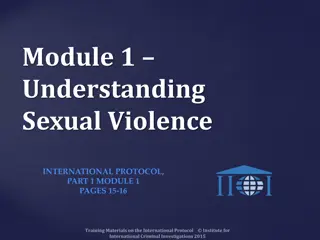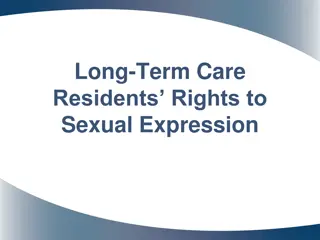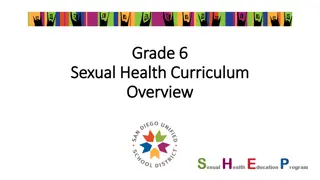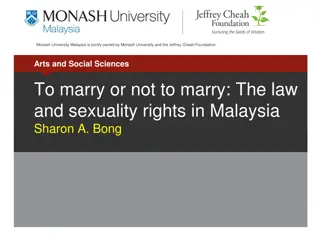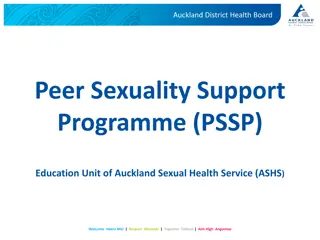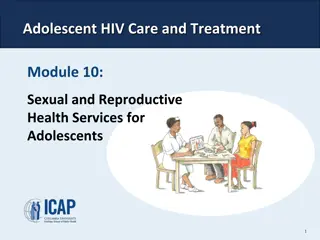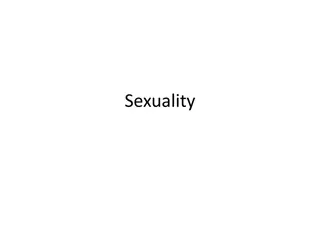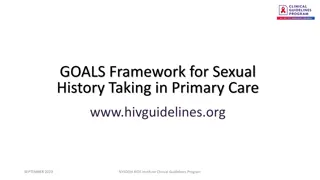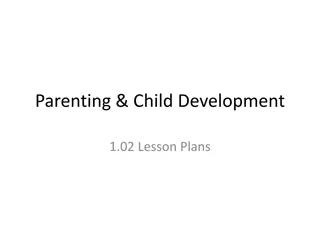Talking to Our Children About Sexuality: A Guide for Sexual Health Educators
This resource provides valuable information for sexual health educators on discussing sexuality with children. It includes key messages, Nunavut-specific resources, where to use the material, what sexuality encompasses, and why starting the conversation early is crucial for children's development.
Download Presentation

Please find below an Image/Link to download the presentation.
The content on the website is provided AS IS for your information and personal use only. It may not be sold, licensed, or shared on other websites without obtaining consent from the author.If you encounter any issues during the download, it is possible that the publisher has removed the file from their server.
You are allowed to download the files provided on this website for personal or commercial use, subject to the condition that they are used lawfully. All files are the property of their respective owners.
The content on the website is provided AS IS for your information and personal use only. It may not be sold, licensed, or shared on other websites without obtaining consent from the author.
E N D
Presentation Transcript
Talking to our Children about Sexuality Information for Sexual Health Educators January 2017 Please contact sexualhealth@gov.nu.ca if you need support to teach this topic.
Nunavut-Specific Sexual Health Resource for Parents/ Caregivers Available at: www.irespectmyself.ca, from local CHR, or by contacting sexualhealth@gov.nu.ca
Where to use this resource Presentations at CPNP or other parent groups A take-home resource from pre-natal or well- child visits Leave in the waiting room for people to pick up Nurses can give to parents at the health centre during well child checks or other visits As a give-away at a health fair or store booth
Key Messages for Parent/ Caregiver Resource Sexuality is not just about sex! Talking about sexuality helps young people make decisions. Kids of different ages need different information. It s important to talk to both boys and girls. It might feel awkward at first, but it gets easier!
What is sexuality? Values what is important to us Communication how we talk to others Relationships Body Image and Self-Esteem how we feel about ourselves Anatomy and Physiology body parts Sexuality Physical Expression - sex Sexual orientation, gender roles, identity Decision Making
Why do we need to start talking about sexuality when children are young? Because sexuality is about communication, relationships, feelings, and self-esteem. When we talk about communication, relationships, feelings, and self-esteem at a young age, children learn how to behave as adults.
Thoughts-Feelings-Behaviour Triangle Feelings Thoughts Behaviours
Thoughts-Feelings-Behaviour Triangle I m ugly and stupid. No one will ever love me. I don t deserve a good relationship. I ll stay in this relationship, even though he/ she hurts me and won t agree to use a condom, because it s what I deserve and the best I can get.
Thoughts-Feelings-Behaviour Triangle Boys are strong. Strength means not crying, and never showing weakness. I can t cry, I can t be vulnerable, but I m hurting. Drinking to numb pain and hurt. Violence, anger, frustration.
Thoughts-Feelings-Behaviour Triangle Sex is dirty and something I m not supposed to do. The words are shameful and embarrassing. I m ashamed of the way I feel. I feel like I can t talk to anyone about this. I can t ask my parents for advice. I can t talk to my partner about using a condom. I can t ask a nurse about getting an STI test.
Changing the thoughts What can parents, caregivers, and educators do? Talk about the extras self-esteem, body image, communication, relationships, feelings. From a young age, tell children they are good and smart and deserve good things.
Thoughts-Feelings-Behaviour Triangle I m smart. I deserve good things. My parent/ teacher/ neighbour told me so. I m proud of who I am. I m confident that I can keep myself safe. I want to BE someone! I m going to ask my partner to use a condom. I m going to use birth control.
Talking to our children about sexual health can help them: Be safe Be happy Be healthy Have good relationships Feel good about their bodies Have children when they re ready Wait until they are ready to have sex
Children and youth need different information at different ages
Ages 0-2 Name body parts penis, vagina, bum, breasts
Ages 2-7 Public and private parts and activities. Who can touch them, when. Be specific! Safe and unsafe touch. Tell them to tell you, that you won t be mad, and it s not their fault. Recognize and name feelings. Answer questions simply.
Ages 7-12 How babies are made Family values and expectations Build self-esteem Puberty (age 8-9) Sexually transmitted infections and birth control (ages 10-12)
Ages 13-18 Start conversations More detail - STIs and birth control Healthy and unhealthy relationships Decision making be specific! Build self-esteem Promote safety Build skills, including communication
Reminder about age of consent for sexual activity
Note for educators regarding consent for STI testing/ treatment and birth control: Anyone, of any age, can come to the health centre for STI testing/ treatment and birth control. If the person is young, the nurse may ask a few extra questions to be sure that the person is not being sexually abused and to be sure that the person understands the benefits and risks of treatment.
Our role as sexuality educators Build our participants Knowledge Skills Confidence How can we do this?
Best Ways to Teach Find out what they already know Make them feel good about themselves recognize success! Make it relevant to their life Focus on good things not just fear Humour get the giggles out Drama/ Role Play Telling stories Yell out words to get comfortable saying them Arts and crafts Songs Radio and TV script writing Videos Activities and games Debates Expert groups have them teach themselves! Storytelling Hands-on Pictures Guest speakers Field trips Question box Ask questions to check participant s understanding
Tips for educators teaching sexual health Be honest, open, and welcoming Keep your sense of humour Don t worry if the conversation isn t perfect Use TV shows, music, movies, the news, and real life to start a conversation.
People wont remember what you said or what you did. They will remember how you made them feel.
Activities for helping parents and caregivers talk to children and youth about sexual health Icebreaker Trains, Mad Libs, Kleenex activity, Two Truths and a Lie Think-Pair-Share Videos Gallery Walk Teachable Moments
Consider Asking a respected Elder to come in and speak about the topic to share traditional knowledge and values. Meet with the Elder in advance to discuss the topic and ensure appropriate, inclusive, and respectful sharing of knowledge. Consider whether there is any potential for hurt or harm in the information being shared. After the Elder leaves, have a discussion with your group about similarities and differences between traditional and modern knowledge. Be prepared to answer questions with objective, factual, and up-to- date information.
Please review Teaching Sexual Health Background Information for Educators at www.irespectmyself.ca. Please check out the Helping Parents Classroom Presentation and Lesson Plan at www.irespectmyself.ca. Want more information about talking to children and youth about sexuality? www.irespectmyself.ca http://parents.teachingsexualhealth.ca/topics/resources.html www.inuithealthmatters.aboutkidshealth.ca/ http://www.upworthy.com/5-everyday-ways-to-teach-your-kids-about-consent Red Cross Be Safe Kit (available in schools; training available online at: http://www.redcross.ca/how-we-help/violence--bullying-and-abuse- prevention/educators/child-abuse-and-neglect-prevention/program-for-young- children--be-safe--can-help-prevent-sexual-abuse-of-children) http://www.ippf.org/sites/default/files/2016- 10/Putting%20Sexuality%20back%20into%20Comprehensive%20Sexuality%20Edu cation_0.pdf


